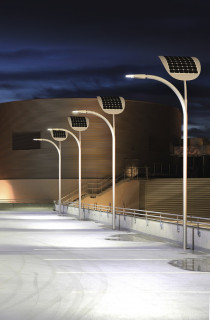In the past few years, the Smart Grid has gained a lot of popularity, mainly due to the fact that it promises a more intelligent, efficient, and reliable use of the power resources, while also providing a better quality of service to the customers. The advances in the technology of renewable energy sources have also contributed to the increased dependence on renewable energy, as opposed to the conventional fossil-based sources. In this paper, we demonstrate an idea for using renewable energy sources; namely, solar energy, to power a street lighting system, which could alleviate a lot of stress on the conventional power grid, and take us a step further in the process of moving towards a more intelligent power grid.
One of the biggest expenditures in Smart Solar street light system is the battery.
Batteries in solar street lights have to meet the demands of unstable grid energy, charging and discharging cycles and irregular full recharging. There is a variety of battery types that can meet these unique requirements. Main considerations when choosing a battery for smart solar street lights include cost, cycle life, installation and maintenance cost.
Below we addressed these aspects for each battery technology, as well as some best practices when selecting batteries for a solar installation
1) Lead Acid (most common in smart solar street light application)
Deep-cycle, lead-acid batteries have been employed in renewable energy and reliably used in off-grid applications globally for decades.
Cost: Typical deep-cycle, lead-acid batteries cost about half as much as lithium-ion.
Cycling: Valve-regulated lead-acid (VRLA) batteries include absorbed glass mat (AGM) and gel models. Many AGMs batteries available in the market are primarily built for dual-purpose or standby applications like emergency backup, but not deep cycling. However, new deep-cycle AGM designs have increased performance and total energy output making them a good choice for renewable energy applications at a lower price point than gel batteries.
Replacement/maintenance: Many factors including initial design and ongoing maintenance influence battery life so it’s difficult to put a time frame on when the batteries will need replacement. Flooded lead-acid batteries have to be refilled regularly because the electrolyte that fully submerges the battery plates evaporates during charging. The battery enclosure needs ventilation to keep hydrogen gas from accumulating to dangerous levels.
AGM and gel technologies, however, are recombination, meaning they internally convert hydrogen and oxygen into water and do not require maintenance. As there is no free acid inside these batteries, they can be installed in any position other than upside down. Because solar applications can be in hard-to-reach or remote areas, the ability to install the batteries and let them operate over long periods without maintenance is a benefit.
2) Lithium-ion
According to a U.S. Solar Energy Monitor report, lithium-ion batteries are the most best storage technology, regardless of application. There are three types: pouches such as in smartphones and tablets, cylindrical such as in power tools, and prismatic such as in electronic vehicles. Prismatic types often have corrugated sides, which create air gaps between adjacent cells and can aid in cooling. The prismatic can have applications in solar energy storage, specifically lithium iron phosphate (LFP) batteries.
Cost: At least twice as much as lead acid batteries. However the economy of scale and large number of new factories that have been created in last couple of years definitely drew the price of lithium batteries down. The new Tesla's Gigafactory will be a game changer for lithium ion indusry. Analysts expect that the price for this battery type will drop by 40% in next couple of years due to all these trends. In that case the lithium battery will be natural and rational choice for Smart Solar Street light application considering that it has much better cycle life, smaller size and weight which can open doors for new Smart Solar Street lights designs.
Cycling: Lithium-ion batteries can typically deliver more cycles in their lifetime than lead-acid. This makes them a good choice for applications when batteries are cycled to provide ancillary services to the grid. The most important benefit lithium-ion provides for solar is its high charge and discharge efficiencies, which help harvest more energy. Lithium-ion batteries also lose less capacity when idle, which is useful in solar installations where energy is only used occasionally.
Replacement/maintenance: Lithium-ion batteries can be lighter and more self contained than lead-acid batteries, so may be easier to install and change out. They can be wall-mounted and located indoors or outdoors. They are solid, so don’t require refills or maintenance.






As a layman I have a question that might sound naive. Would it not be preferable to fuel the grid by renewable energy, have solar panels at the roofs to discharge the grid and feed the street light by the grid. In tis case, batteries nor massive solar panels on top of each lamppost are needed.